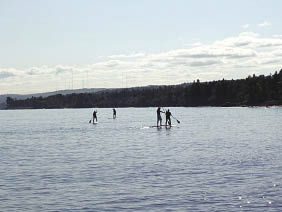By
When the rivers break free of winter’s icy embrace, it’s time for the spring migration of whitewater kayakers. During April and May, advanced whitewater kayakers travel from all over the country to be baptized in the roaring cascades of North Shore rivers.
Lake Superior’s North Shore is home to rugged hills dropping sharply to the lake. Scattered from Duluth to Thunder Bay are over 20 “runnable” rivers; some with sections having gradients of over 100 feet per mile.
John Alt, a pioneer of whitewater paddling on the North Shore, notes, “The topography of the North Shore produces whitewater runs that can’t be found anywhere else. And with the lack of development in the watersheds, the water is very clean.”
The St. Louis, Split Rock, Cascade, Devil Track, Brule, and Kaministiquia are just some of the classic destinations for paddlers looking for Class III – V rivers to run. Due to the high-risk nature of this sport, be sure you have the skills and gear necessary to participate. Paddle with others and know how to use your safety equipment. Most importantly, know your limits.
Adam Harju, activities Director at Lutsen Resort, sees himself as an intermediate level whitewater paddler who had always thought that spring river running was out of his reach. In the last few years, he has discovered smaller rivers along the North Shore that can offer Class II-III paddling. Rivers like the Onion and Kadunce, or sections of the Brule, Cascade, or Temperance, provide memorable whitewater experiences in beautiful, remote areas.
Harju suggests, “If you are tired of doing the same Class III water in the lower part of the state, come up and try some wilderness rivers this spring.”
High water season is short here and depends on snow melt run-off and spring rains–highly variable from year to year. In addition, the “steep creek” nature of the North Shore rivers with their small watersheds adds to the brief nature of the “window of opportunity.” As few of these rivers have gauges, dedicated paddlers have to do their homework to determine river conditions on any particular day.
In the Thunder Bay area, the general slope of the land towards Lake Superior is less steep, and there are more lakes that feed into the rivers. The result is larger rivers, technically a little easier, with significant water flow for longer periods. The Kaministiquia, for instance, can be run well into the summer.
For detailed information about the many whitewater rivers all along the North Shore, check out Jim Rada’s Northwoods Whitewater, A Paddler’s Guide to the Whitewater of Minnesota, Wisconsin, Ontario and Michigan.
When asked about the allure of paddling these North Shore rivers, John Alt replied, “It’s the experience of adventure, the challenge. It focuses all my attention and the rest of my everyday cares disappear. The North Shore offers incredible beauty, and kayaking here takes me through scenic canyons, some of which you can’t see any other way.”
And those are reasons enough for many kayakers to make the spring migration.



